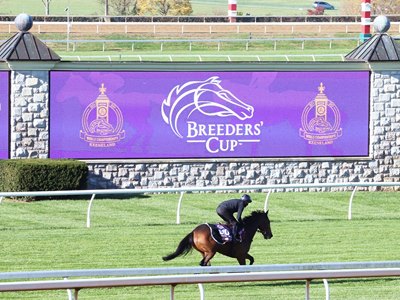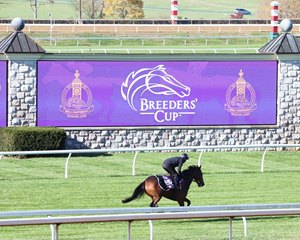Wet Keeneland Turf Drying Before Breeders' Cup


A forecast of mostly sunny fall weather in Central Kentucky this week has Jim Pendergest, director of racing surfaces at Keeneland, encouraged that the track's damp turf course will continue to dry before the Breeders' Cup World Championships Nov. 6-7.
According to the National Weather Service as of 3 p.m. ET Nov. 3, dry conditions are expected through the Breeders' Cup with high temperatures in the 60s before climbing to around 70 on Saturday. This dry spell follows a wet end to racing at Keeneland last month as the track wound down its traditional October race dates.
During the track's final three days before racing moved to Churchill Downs in Louisville, Keeneland took some of its races off its turf course to preserve it for the Breeders' Cup.
"The turf looks really good right now. We'd rate it as good," Pendergest said Nov. 3. "We think it's probably going to get to firm by the time we get to Friday with the weather we got coming, getting into the 60s."
The Keeneland course registered a 7.4 reading Tuesday on the GoingStick, a device that measures the saturation of a turf course and its condition. According to data on Keeneland's website, where GoingStick statistical information is listed, readings of between 7.0 and 8.9 fall in the good category.
Per Keeneland's scale, 9.0 to 10.9 is good-to-firm, and 11.0 and higher is firm.
Pendergest anticipates readings of "maybe 7.5 to 7.8" by the two Breeders' Cup days, which would fall in the good classification.
The main track is all but certain to be fast both days barring unforeseen rain.
Pendergest doubts Keeneland will water the grass course in the coming days, and if they do, it will likely be a short 10-minute sprinkling.
Trainer Wesley Ward, based at Keeneland, believes the course will have give in it for the Breeders' Cup. He said he could tell the course was laboring when he worked Breeders' Cup Juvenile Fillies Turf (G1T) entrant Royal Approval and Juvenile Turf Sprint (G2T) also eligible Gypsy King over it Nov. 1. Each took over 1:05 to complete five furlongs on good turf, though protective cones on the course kept them on the outer portion of the grass, leading to ground loss and contributing to the slow time.
"They were sinking in. Their works weren't as eye-opening as they were prior," Ward said.
Wet turf is generally thought to favor Europeans, who have more experience on such ground, though some U.S.-based horses, such as the Bill Mott-trained Channel Maker in the Longines Breeders' Turf (G1T), have shown an affinity for damp conditions.
Turf courses have been less than firm during the past two Breeders' Cups in Kentucky, first at Keeneland in 2015 and then at Churchill Downs in 2018.
